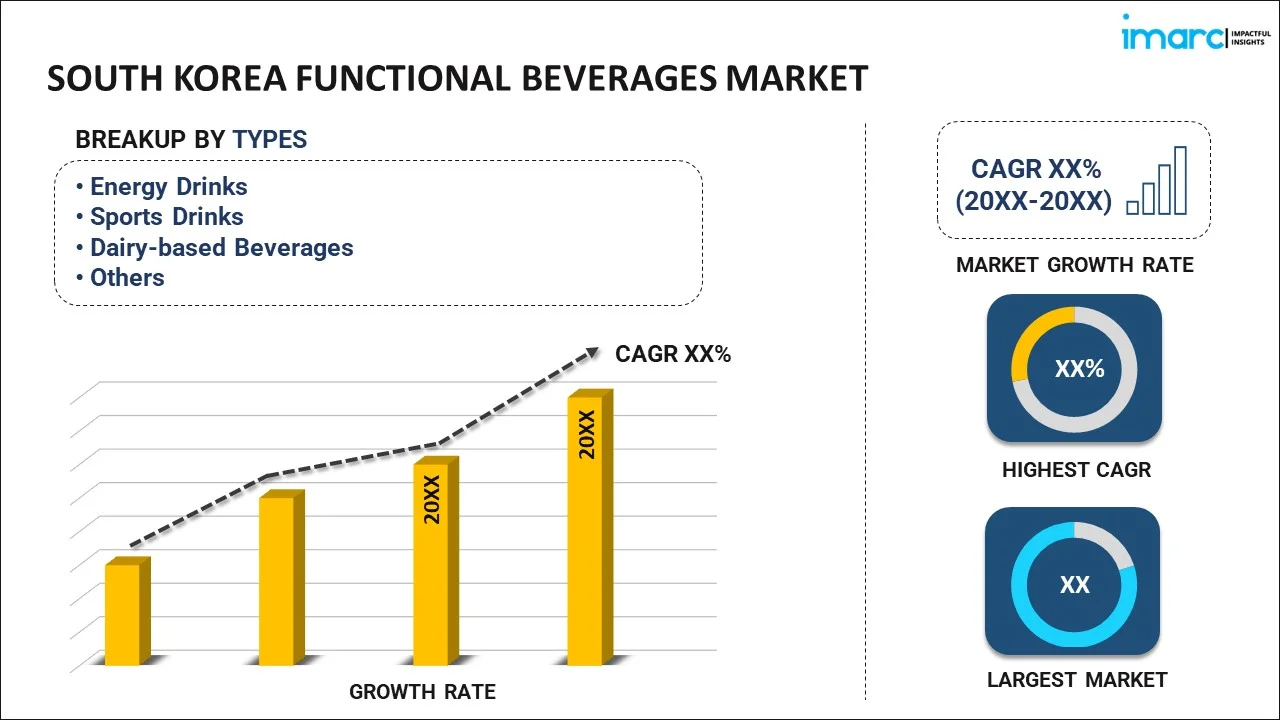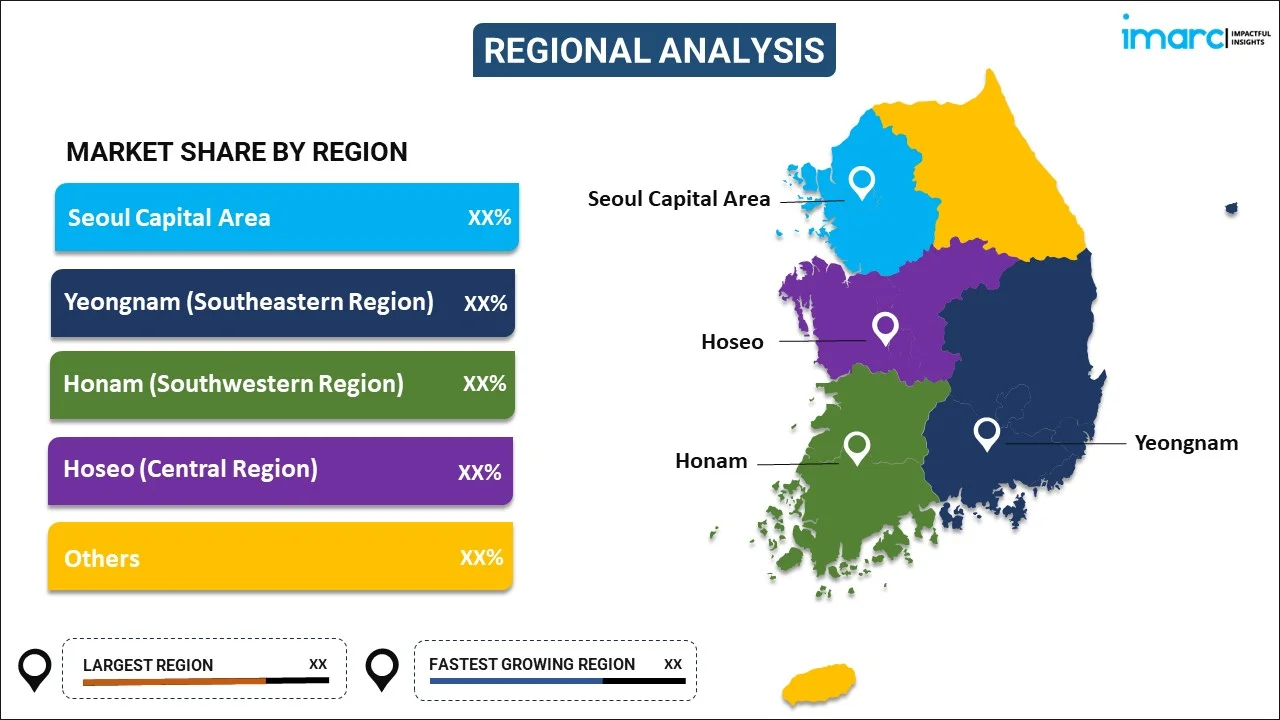
South Korea Functional Beverages Market Report by Type (Energy Drinks, Sports Drinks, Dairy-based Beverages, Juices, and Others), Distribution Channel (Supermarkets and Hypermarkets, Specialty Stores, E-commerce, and Others), End User (Athletes, Fitness Lifestyle Users, and Others), and Region 2025-2033
Market Overview:
South Korea functional beverages market size is projected to exhibit a growth rate (CAGR) of 6.49% during 2025-2033. The increasing health awareness, changing lifestyles, shifting preference for premium products, rising demand for convenience, rising digitalization, favorable government initiatives, aging population, expanding culture of fitness, and heightened health consciousness represent some of the key factors driving the market.
|
Report Attribute
|
Key Statistics
|
|---|---|
|
Base Year
|
2024 |
|
Forecast Years
|
2025-2033 |
|
Historical Years
|
2019-2024
|
| Market Growth Rate (2025-2033) | 6.49% |
Functional beverages are a category of drinks that go beyond simple hydration, offering additional health benefits and performance enhancements. These beverages are formulated with ingredients intended to provide specific physiological or cognitive effects, often promoting overall well-being or targeting particular health concerns. Compared to traditional beverages that primarily quench thirst, functional beverages are designed to serve a dual purpose by delivering nutrients, vitamins, minerals, or other bioactive compounds. Common ingredients found in functional beverages include vitamins, antioxidants, herbs, amino acids, and functional botanicals. Some of the standard functional beverages include energy drinks, which typically contain caffeine and other stimulants to boost alertness, and sports drinks, which aim to replenish electrolytes and enhance hydration. Besides this, numerous functional beverages are focused on stress reduction, immune support, and cognitive enhancement, each tailored to address specific health or lifestyle needs. These drinks help enhance physical performance, support mental focus, or aid recovery, reflecting a shift toward a more holistic approach to beverages, integrating functionality with taste and convenience.
South Korea Functional Beverages Market Trends:
The increasing awareness of health and wellness represents the key factor driving the demand for functional beverages with added benefits, such as vitamins, antioxidants, and other bioactive compounds. In line with this, consumers in South Korea are actively seeking alternatives to traditional sugary drinks, fostering a shift towards beverages that not only quench thirst but also provide specific health advantages. Moreover, the expanding influence of global wellness trends has led to the popularity of functional beverages that cater to specific health concerns, such as energy boosters, immunity enhancers, and stress relievers, creating a favorable outlook for market expansion. In confluence with this, the rise in disposable income and changing lifestyles have contributed to a growing willingness to spend on premium and health-focused products, providing an impetus to the market growth. Concurrently, the prevalence of hectic urban lifestyles resulting in an increased demand for on-the-go and convenient nutritional solutions has positioned functional beverages as a practical and accessible choice for busy consumers, aiding in market expansion. In addition to this, the emphasis on preventive healthcare and the desire for products that support overall well-being have fueled the demand for functional beverages with ingredients promoting heart health, cognitive function, and digestive wellness. Furthermore, favorable government initiatives promoting a healthier lifestyle and campaigns encouraging reduced consumption of sugary beverages have contributed to the shift towards functional beverages perceived as healthier alternatives, thereby bolstering the market growth. Apart from this, the increasing aging population in South Korea spurring the demand for functional beverages addressing age-related health concerns, such as joint health and bone density are presenting lucrative opportunities for market expansion.
South Korea Functional Beverages Market Segmentation:
IMARC Group provides an analysis of the key trends in each segment of the market, along with forecasts at the country level for 2025-2033. Our report has categorized the market based on type, distribution channel, and end user.
Type Insights:

- Energy Drinks
- Sports Drinks
- Dairy-based Beverages
- Juices
- Others
The report has provided a detailed breakup and analysis of the market based on the type. This includes energy drinks, sports drinks, dairy-based beverages, juices, and others.
Distribution Channel Insights:
- Supermarkets and Hypermarkets
- Specialty Stores
- E-commerce
- Others
A detailed breakup and analysis of the market based on the distribution channel have also been provided in the report. This includes supermarkets and hypermarkets, specialty stores, e-commerce, and others.
End User Insights:
- Athletes
- Fitness Lifestyle Users
- Others
The report has provided a detailed breakup and analysis of the market based on the end user. This includes athletes, fitness lifestyle users, and others.
Regional Insights:

- Seoul Capital Area
- Yeongnam (Southeastern Region)
- Honam (Southwestern Region)
- Hoseo (Central Region)
- Others
The report has also provided a comprehensive analysis of all the major regional markets, which include Seoul Capital Area, Yeongnam (Southeastern Region), Honam (Southwestern Region), Hoseo (Central Region), and Others.
Competitive Landscape:
The market research report has also provided a comprehensive analysis of the competitive landscape in the market. Competitive analysis such as market structure, key player positioning, top winning strategies, competitive dashboard, and company evaluation quadrant has been covered in the report. Also, detailed profiles of all major companies have been provided.
South Korea Functional Beverages Market Report Coverage:
| Report Features | Details |
|---|---|
| Base Year of the Analysis | 2024 |
| Historical Period | 2019-2024 |
| Forecast Period | 2025-2033 |
| Units | Million USD |
| Scope of the Report | Exploration of Historical Trends and Market Outlook, Industry Catalysts and Challenges, Segment-Wise Historical and Future Market Assessment:
|
| Types Covered | Energy Drinks, Sports Drinks, Dairy-based Beverages, Juices, Others |
| Distribution Channels Covered | Supermarkets and Hypermarkets, Specialty Stores, E-commerce, Others |
| End Users Covered | Athletes, Fitness Lifestyle Users, Others |
| Regions Covered | Seoul Capital Area, Yeongnam (Southeastern Region), Honam (Southwestern Region), Hoseo (Central Region), Others |
| Customization Scope | 10% Free Customization |
| Post-Sale Analyst Support | 10-12 Weeks |
| Delivery Format | PDF and Excel through Email (We can also provide the editable version of the report in PPT/Word format on special request) |
Key Questions Answered in This Report:
- How has the South Korea functional beverages market performed so far and how will it perform in the coming years?
- What has been the impact of COVID-19 on the South Korea functional beverages market?
- What is the breakup of the South Korea functional beverages market on the basis of type?
- What is the breakup of the South Korea functional beverages market on the basis of distribution channel?
- What is the breakup of the South Korea functional beverages market on the basis of end user?
- What are the various stages in the value chain of the South Korea functional beverages market?
- What are the key driving factors and challenges in the South Korea functional beverages?
- What is the structure of the South Korea functional beverages market and who are the key players?
- What is the degree of competition in the South Korea functional beverages market?
Key Benefits for Stakeholders:
- IMARC’s industry report offers a comprehensive quantitative analysis of various market segments, historical and current market trends, market forecasts, and dynamics of the South Korea functional beverages market from 2019-2033.
- The research report provides the latest information on the market drivers, challenges, and opportunities in the South Korea functional beverages market.
- Porter's five forces analysis assist stakeholders in assessing the impact of new entrants, competitive rivalry, supplier power, buyer power, and the threat of substitution. It helps stakeholders to analyze the level of competition within the South Korea functional beverages industry and its attractiveness.
- Competitive landscape allows stakeholders to understand their competitive environment and provides an insight into the current positions of key players in the market.
Need more help?
- Speak to our experienced analysts for insights on the current market scenarios.
- Include additional segments and countries to customize the report as per your requirement.
- Gain an unparalleled competitive advantage in your domain by understanding how to utilize the report and positively impacting your operations and revenue.
- For further assistance, please connect with our analysts.
 Request Customization
Request Customization
 Speak to an Analyst
Speak to an Analyst
 Request Brochure
Request Brochure
 Inquire Before Buying
Inquire Before Buying




.webp)




.webp)












